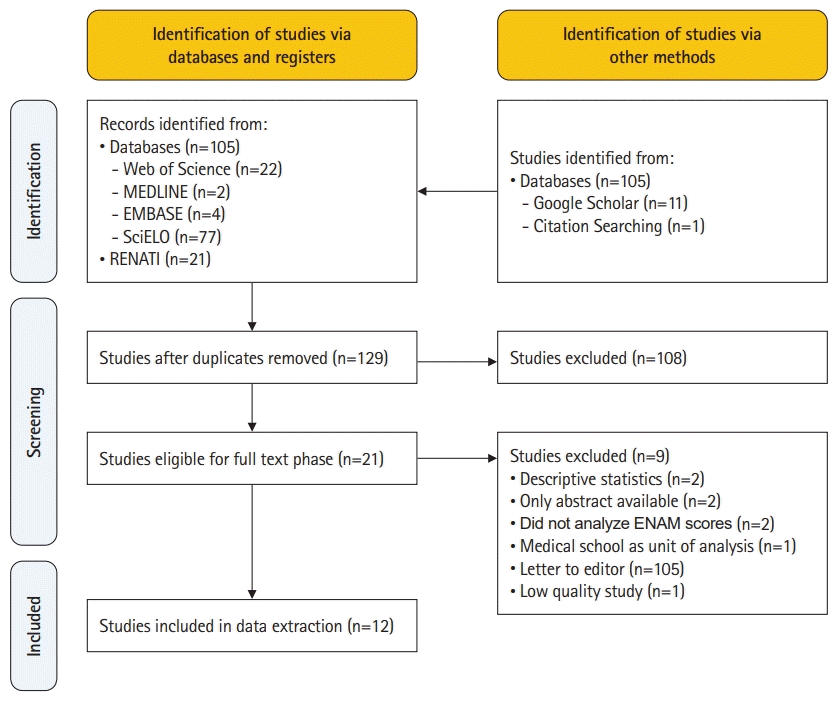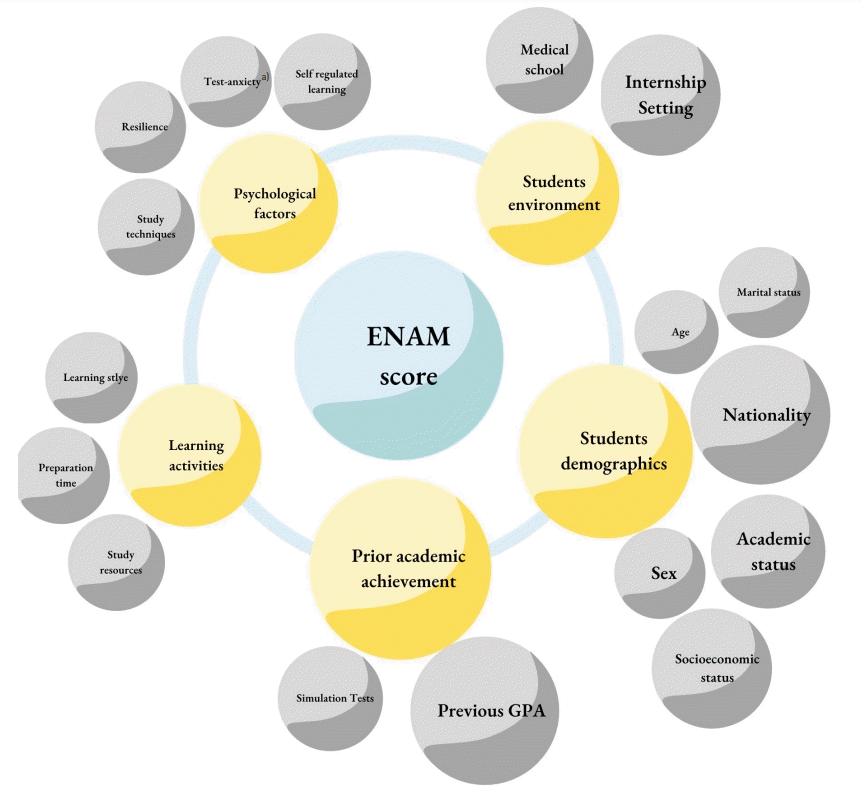1. Price T, Lynn N, Coombes L, Roberts M, Gale T, de Bere SR, Archer J. The international landscape of medical licensing examinations: a typology derived from a systematic review. Int J Health Policy Manag. 2018; 7:782–790.
https://doi.org/10.15171/ijhpm.2018.32.
3. Archer J, Lynn N, Coombes L, Roberts M, Gale T, Price T, Regan de Bere S. The impact of large scale licensing examinations in highly developed countries: a systematic review. BMC Med Educ. 2016; 16:212.
https://doi.org/10.1186/s12909-016-0729-7.
7. Mendoza Chuctaya G, Calla Torres M, Ramos Chuctaya K, Mejia Alvarez C. National medicine exam: an analysis of the last decade of theoretical exams in Peruvian last year medical students. Acta Med Peru. 2021; 38:169–176.
https://doi.org/10.35663/amp.2021.383.2164.
10. Page MJ, McKenzie JE, Bossuyt PM, Boutron I, Hoffmann TC, Mulrow CD, Shamseer L, Tetzlaff JM, Akl EA, Brennan SE, Chou R, Glanville J, Grimshaw JM, Hrobjartsson A, Lalu MM, Li T, Loder EW, Mayo-Wilson E, McDonald S, McGuinness LA, Stewart LA, Thomas J, Tricco AC, Welch VA, Whiting P, Moher D. The PRISMA 2020 statement: an updated guideline for reporting systematic reviews. BMJ. 2021; 372:n71.
https://doi.org/10.1136/bmj.n71.
12. Reed DA, Cook DA, Beckman TJ, Levine RB, Kern DE, Wright SM. Association between funding and quality of published medical education research. JAMA. 2007; 298:1002–1009.
https://doi.org/10.1001/jama.298.9.1002.
15. Baldera Aquino JE, Alvarado Alva FJ. Test anxiety, degree of satisfaction in hospital practices and learning strategies in the result of the national medical examination: professional school of human medicine of the Hermilio Valdizan National University, from 2016 to 2018 [Internet]. Pillco Marca: Hemilio Valdizan National University;2021. [cited 2022 Sep 9]. Available from:
https://hdl.handle.net/20.500.13080/6378.
16. Flores Cohaila JA. Association between the weighted university average and progress exams of basic sciences and clinical sciences compared to the score obtained from the ENAM 2020 in medical interns of the Private University of Tacna [Internet]. Tacna: Private University of Tacna;2021. [cited 2022 Sep 9]. Available from:
http://repositorio.upt.edu.pe/handle/20.500.12969/1940.
17. Franco Miranda WJ. Some sociodemographic factors associated with academic performance in medical interns at level III hospitals in the southern region [Internet]. Arequipa: National University of Arequipa;2020. [cited 2022 Sep 9]. Available from:
http://hdl.handle.net/20.500.12773/12027.
18. Huamani C, Gutierrez C, Mezones-Holguin E. Correlation and concordance between the national test of medicine (ENAM) and the grade point average (GPA): analysis of the Peruvian experience in the period 2007 - 2009. Rev Peru Med Exp Salud Publica. 2011; 28:62–71.
https://doi.org/10.1590/s1726-46342011000100010.
19. Quispe Chacon ME. Factors related to performance in the evaluation of the national medical examination (ENAM) in graduates of the Faculties of Medicine of Arequipa 2017 [Internet]. Arequipa: National University of San Agustin of Arequipa;2018. [cited 2022 Sep 9]. Available from:
http://repositorio.unsa.edu.pe/handle/UNSA/5560.
20. Ramos Supa J. Techniques, motivation, study habits and student academic performance associated with the score obtained in the national medical examination (ENAM) in interns of the National University of San Agustin of Arequipa (UNSA) [Internet]. Arequipa: National University of San Agustin of Arequipa;2018. [cited 2022 Sep 10]. Available from:
http://repositorio.unsa.edu.pe/handle/UNSA/10895.
21. Salazar Saavedra OV. Factors associated with the grade obtained in the national medical examination by interns of a Peruvian public university in Lima in 2013 and 2014 [Internet]. Lima: National University of San Marcos;2015. [cited 2022 Sep 10]. Available from:
https://hdl.handle.net/20.500.12672/4135.
22. Sosa Espinoza DY, Sulca Correa JA. Association between university academic performance, learning styles, hospital location where the internship was performed with the grade obtained in the national medical examination by students of the Hermilio Valdizan National University in Huanuco during the years 2012 to 2015 [Internet]. Pillco Marca: Hemilio Valdizan National University;2018. [cited 2022 Sep 9]. Available from:
http://repositorio.unheval.edu.pe/handle/20.500.13080/3044.
23. Vojvodic Hernandez IM. Resilient factors and cognitive skills of medical interns at the Edgardo Rebagliati-EsSalud Hospital - 2018 [Internet]. Lima: University of San Martin of Porres;2019. [cited 2022 Nov 1]. Available from:
https://repositorio.usmp.edu.pe/handle/20.500.12727/5004.
24. Zuni Chavez KX. Learning styles and their association with the ENAM score in human medicine interns at the Arzobispo Loayza National Hospital and the Sergio E. Bernales Hospital, 2017 [Internet]. Lima: National Register of Peruvian Research;2018. [cited 2022 Nov 1]. Available from:
https://renati.sunedu.gob.pe/handle/sunedu/3129840.
25. Domenech-Betoret F, Gomez-Artiga A, Abellan-Rosello L, Rocabert-Beut E. MOCSE centered on students: validation of learning demands and teacher support scales. Front Psychol. 2020; 11:582926.
https://doi.org/10.3389/fpsyg.2020.582926.
26. Kocak O, Goksu I, Goktas Y. The factors affecting academic achievement: a systematic review of meta analyses. Int Online J Educ Teach. 2021; 8:454–484.
28. Jacobparayil A, Ali H, Pomeroy B, Baronia R, Chavez M, Ibrahim Y. Predictors of performance on the United States Medical Licensing Examination step 2 clinical knowledge: a systematic literature review. Cureus. 2022; 14:e22280.
https://doi.org/10.7759/cureus.22280.
29. Hirumi A, Horger L, Harris DM, Berry A, Daroowalla F, Gillum S, Dil N, Cendan JC. Exploring students [pre-pandemic] use and the impact of commercial-off-the-shelf learning platforms on students’ national licensing exam performance: a focused review: BEME guide no. 72. Med Teach. 2022; 44:707–719.
https://doi.org/10.1080/0142159X.2022.2039380.
30. Broadbent J, Poon WL. Self-regulated learning strategies & academic achievement in online higher education learning environments: a systematic review. Internet High Educ. 2015; 27:1–13.
https://doi.org/10.1016/j.iheduc.2015.04.007.
31. Green M, Angoff N, Encandela J. Test anxiety and United States Medical Licensing Examination scores. Clin Teach. 2016; 13:142–146.
https://doi.org/10.1111/tct.12386.
32. Huntley CD, Young B, Temple J, Longworth M, Smith CT, Jha V, Fisher PL. The efficacy of interventions for test-anxious university students: a meta-analysis of randomized controlled trials. J Anxiety Disord. 2019; 63:36–50.
https://doi.org/10.1016/j.janxdis.2019.01.007.





 PDF
PDF Citation
Citation Print
Print





 XML Download
XML Download